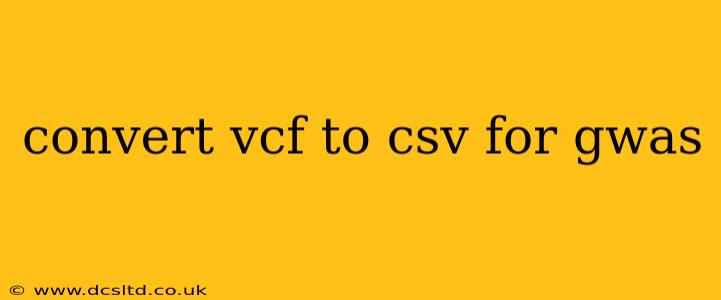Genome-wide association studies (GWAS) rely heavily on well-formatted data. While VCF (Variant Call Format) files are the standard for storing genomic variant data, CSV (Comma Separated Values) files often provide a more convenient format for analysis and downstream applications in GWAS. This guide will walk you through the process of converting VCF to CSV, highlighting best practices and considerations for ensuring data integrity and successful GWAS analysis.
Why Convert VCF to CSV for GWAS?
VCF files, while powerful, can be cumbersome for certain GWAS analysis tools. Their complex structure, containing multiple info fields and potentially large numbers of samples, can make processing challenging. CSV files offer a simpler, more readily accessible format, making them ideal for:
- Compatibility: Many statistical packages and GWAS analysis software work more efficiently with CSV data.
- Data Manipulation: CSV files are easier to manipulate and filter using spreadsheet programs like Excel or specialized data manipulation tools.
- Visualization: Visualizing results is often simpler with CSV data in commonly used visualization software.
Methods for VCF to CSV Conversion
Several approaches exist for converting VCF files to CSV suitable for GWAS. The optimal method depends on the complexity of your VCF file and your preferred tools.
1. Using bcftools (Command-Line Tool)
bcftools is a powerful command-line tool within the htslib suite. It offers excellent flexibility and control over the conversion process. A basic conversion might look like this:
bcftools query -f '%CHROM\t%POS\t%ID\t%REF\t%ALT\t%QUAL\n' input.vcf > output.csv
This command extracts specific fields (chromosome, position, ID, reference allele, alternate allele, quality) from input.vcf and saves them to output.csv. You can customize the -f option to include additional fields relevant to your GWAS analysis. Remember to replace input.vcf with your actual file name. For more complex scenarios or handling of INFO fields, explore the bcftools query documentation for advanced options.
2. Utilizing Python Scripts
Python, with its rich bioinformatics libraries like pysam, provides great flexibility for VCF parsing and manipulation. You can create custom scripts to extract specific fields and perform data transformations before converting to CSV. This approach is particularly beneficial when you need to perform complex data cleaning or filtering steps as part of the conversion.
3. Employing R Packages
R, a widely used statistical programming language, offers several packages capable of reading and manipulating VCF data. Packages such as VariantAnnotation and SNPRelate can be used to import VCF files, extract relevant information, and export the data into a CSV format tailored for GWAS.
4. Commercial Software Solutions
Several commercial genomic analysis software packages include built-in tools for VCF to CSV conversion and GWAS analysis. These often offer user-friendly interfaces and streamline the entire workflow.
Essential Considerations for GWAS
Regardless of the method you choose, several key considerations ensure your data is properly formatted for GWAS analysis:
Selecting Relevant Fields
Carefully choose the fields you include in your CSV file. For GWAS, essential fields typically include:
- Chromosome: The chromosome where the variant is located.
- Position: The genomic position of the variant.
- Reference Allele: The reference nucleotide(s) at the variant position.
- Alternate Allele: The alternative nucleotide(s) at the variant position.
- Genotype Data: This will vary based on your GWAS software, but it will represent the genotype of each individual at that SNP. This is often represented numerically (e.g., 0, 1, 2 for homozygous reference, heterozygous, homozygous alternate, respectively).
- Other relevant fields: Depending on your analysis, additional INFO fields might be crucial, such as allele frequencies or functional annotations.
Data Cleaning and Quality Control
Before conversion, ensure your VCF file undergoes thorough quality control (QC) to remove low-quality variants or individuals. This is crucial for reliable GWAS results.
Handling Missing Data
Implement a consistent strategy to handle missing data (e.g., represent missing genotypes with "NA" or a specific numerical code).
Data Integrity
Verify the accuracy of your converted CSV file by comparing it with the original VCF file, especially for key fields.
Conclusion
Converting VCF to CSV for GWAS is a critical step in the analysis pipeline. By selecting an appropriate method and carefully considering data quality and formatting, researchers can ensure their data is ready for powerful and reliable GWAS analyses, leading to more robust and meaningful results. Remember to consult the documentation for your chosen GWAS software for specific input requirements.
